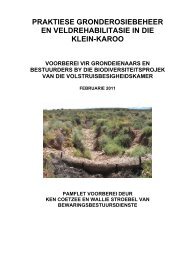REHABILITATION: REHABILITATION: A QUICK GUIDE A ... - saobc
REHABILITATION: REHABILITATION: A QUICK GUIDE A ... - saobc
REHABILITATION: REHABILITATION: A QUICK GUIDE A ... - saobc
Create successful ePaper yourself
Turn your PDF publications into a flip-book with our unique Google optimized e-Paper software.
2. <strong>REHABILITATION</strong> METHODS<br />
The following is a general description of the rehabilitation methods that can be used<br />
at Sites 1 - 4. In most cases, elements of all the methods described will be needed<br />
at each site. The specific needs are summarized at the end of the report in Section<br />
5.<br />
2.1 SOIL EROSION RESULTING FROM ROADS AND TRACKS<br />
Without proper provision for off-road drainage, roads in the veld are often the cause<br />
of accelerated soil erosion. The road tracks effectively channel water, accelerating<br />
the flow downhill where the outflow often results in gulley erosion in the natural veld.<br />
Inadequate roadway runoff at Sites 1, 2 & 3 have resulted in accelerated gulley<br />
erosion and consequent aridification of the veld alongside the gulleys. The<br />
installation of effective road drainage management is thus a priority, not just in<br />
terms of the preservation of the road itself, but also in terms of the negative impact<br />
that the road-induced soil erosion has on the adjacent veld. The following methods<br />
are recommended:<br />
2.1.1 WATER DRAINAGE OFF ROAD SURFACES<br />
The objective with road drainage is to deflect runoff water off the road surface and<br />
into the natural vegetation alongside the road. This can be achieved effectively by<br />
constructing drainage deflection humps across the road surface as illustrated in<br />
Figure 3A.<br />
Effective drainage will prevent the continuous loss of road surface gravel, obviating<br />
the need for expensive resurfacing every time it rains. The drainage hump slows<br />
the water flow, directs it off the road surface and concentrates it at a stable overflow<br />
site.<br />
The number of drainage humps required depends on the steepness of the slope,<br />
nature of the runoff, type of terrain, soil and vegetation cover through which the<br />
road passes as well as the number of natural drainages that cross the road.<br />
Generally, in the type of terrain in the study area, a good practical guide is to build<br />
the humps no more than 50m apart.<br />
Drainage humps are easy to build, but certain essential requirements must be met<br />
for them to be effective. Figure 3A highlights the particular design requirements.<br />
Drainage humps must be constructed with a solid core of either stones or coarse<br />
gravel covered with road surface material to form a gradual slope on both sides,<br />
and should extend well beyond the edge of the roadway on each side to prevent<br />
water from simply flowing around the hump and back into the road.<br />
Drainage humps, particularly the core of rough material, are best built by hand<br />
because great care must be taken to ensure effective water deflection. The final<br />
2



